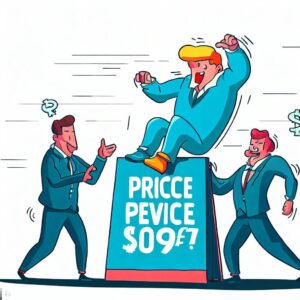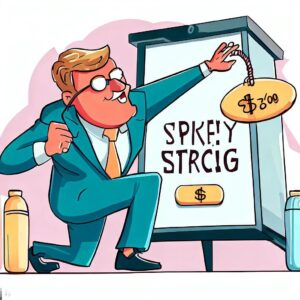The importance of prospecting in sales because prospecting is an essential part of the process. Without prospecting, businesses may struggle to find new leads or customers, which could ultimately impact their revenue and growth. Therefore, prospecting should be given due attention and investment to ensure that the sales pipeline is consistently filled with potential buyers. It involves finding potential customers who might be interested in buying your products or services. However, many salespeople make the mistake of simply taking whoever they can get, without thinking about whether that person is a good fit for their business. This can lead to frustration and disappointment down the line, as the wrong prospect may not be willing or able to buy from you at the prices you want to command.
That’s why it’s important to be strategic when choosing your prospects. Rather than just taking anyone who comes your way, you should be thinking about who you want to work with and why. This means considering factors like the prospect’s ability to buy, their willingness to pay your prices, and their overall fit with your business.
One way to think about prospecting is to imagine it like fishing. If you want to catch a specific type of fish, you need to use the right bait. For example, if you want to catch deer in your backyard, you wouldn’t put out a 500-pound wheel of cheese. That might attract rats, but it won’t do anything for the deer. Instead, you would put out a salt block, which is the right bait for that particular animal.
The same principle applies to prospecting. If you want to attract the right prospects, you need to use the right bait. This might mean tailoring your marketing message to appeal to a specific type of customer, or targeting your outreach efforts to a particular industry or demographic. The goal is to make sure that the people you’re reaching out to are the ones who are most likely to be interested in what you have to offer.
Of course, even with the right bait, you still need to be selective about the prospects you choose. Not every fish that bites is worth keeping, and not every prospect who shows interest in your business is a good fit. That’s why it’s important to have clear criteria for what makes a good prospect, and to use those criteria to evaluate potential customers.
One key criterion to consider when choosing prospects is their ability to buy. After all, there’s no point in pursuing someone who can’t afford to pay for your products or services. This might mean looking for prospects in a certain income bracket, or targeting businesses that have a certain level of revenue. By focusing on prospects who have the financial means to buy from you, you can increase your chances of success and avoid wasting time on dead-end leads.
Another important criterion to consider is the prospect’s willingness to pay your prices. Even if someone has the ability to buy from you, they might not be willing to pay the prices you want to command. This can be especially challenging if you’re selling a high-end product or service, where price is a major factor. In these cases, it’s important to be upfront about your pricing and to make sure that potential customers understand the value they’ll be getting in return. By targeting prospects who are willing and able to pay your prices, you can ensure that you’re not leaving money on the table.
Finally, it’s important to consider the overall fit between your business and the prospect. Even if someone has the ability and willingness to buy from you, they might not be a good fit for your brand or culture. For example, if you’re a company that prides itself on its environmental sustainability, you might not want to work with a prospect whose values don’t align with yours. By being selective about the prospects you choose, you can ensure that you’re building relationships with customers who will be a good fit for your business in the long run.
Choosing the right prospects is essential to the success of any sales strategy. By using the right bait, focusing on prospects who have the ability and willingness to buy from you, and
Effective Pricing Strategies to Make Your Product More Appealing to Customers

When it comes to presenting prices, there are several approaches you can take to make it more appealing to potential customers. These approaches include presenting the product or service as free, using the context of supply and demand, presenting it as reassuringly expensive, emphasizing its value, and highlighting the investment and effort required to create it.
Firstly, presenting the product or service as free can be an effective strategy. This approach positions the product or service as something that doesn’t cost the customer anything. You can achieve this by highlighting the benefits of the product or service, such as the money that it can save the customer in the long run, or how it can improve their productivity or efficiency. For example, if you’re selling an energy-efficient product, you can highlight how it can save the customer money on their utility bills, and how the energy savings over time will pay for the product, effectively making it free. By positioning the product or service as free, you make the price irrelevant, and the customer may be more likely to purchase it.
Another approach is to use the context of supply and demand to make the price irrelevant. If there are only a few items available, but many people want them, the price becomes less important because someone will pay almost anything to get one. However, if there are many items available, but few people want them, the price becomes critical. So, by creating a perceived scarcity of the product, you can make the price less of an issue. This can be achieved by offering limited-time promotions, or emphasizing the exclusivity of the product.
Presenting the product or service as reassuringly expensive can also be an effective strategy. This approach is based on the idea that people believe that the priciest option is the best or safest one. By positioning the product or service as something that not everyone can afford, you make it more appealing to those who can. This approach can be especially effective in luxury or premium markets, where customers are looking for the best of the best. By emphasizing the exclusivity and high quality of the product or service, you can justify the higher price and make it more appealing.
Another approach is to highlight the value of the product or service. This can be achieved by comparing the price of the product or service to its benefits, such as increased productivity, efficiency, or savings. For example, if you’re selling a course or seminar, you can compare the cost of attending the seminar to the cost of the same information and training obtained elsewhere. By highlighting the value of the product or service, you can make the price seem more reasonable and justifiable.
Lastly, highlighting the investment and effort required to create the product or service can be an effective strategy. This approach is based on the idea that people are willing to pay more for something that required more effort to create. By emphasizing the effort, time, or resources that went into creating the product or service, you can make it more appealing and valuable to the customer. This approach can be especially effective if the product or service is unique or has a compelling story behind it.
There are several approaches you can take when presenting prices to potential customers. By making the price seem irrelevant, reassuringly expensive, emphasizing its value, and highlighting the investment required to create it, you can make the product or service more appealing and valuable to the customer.
Techniques to Justify Prices and Persuade Customers to Buy: A Guide for Sellers

When it comes to selling products or services, there are various techniques that can be used to justify the price and persuade the customer to make a purchase. One of these techniques is to use a formula to calculate the price, which can be particularly effective when selling face to face. Instead of quoting a fee outright, getting a calculator out and performing some calculations in front of the customer can make the price seem more concrete and less negotiable. For example, if the fee is based on the number of days it will take to complete the job, multiplied by a base day fee, the seller can perform the calculation in front of the customer, using a formula like “12,800 multiplied by this and…”. This approach can make the customer feel more confident in the price, as they have seen the calculation being made and can’t question it.
Another technique is to bundle items together and connect them, making them harder to negotiate individually. By bundling items together, the customer is less likely to ask for a discount on individual items, as they are part of a package deal. This can be particularly effective when negotiating items that are typically negotiated, such as a car purchase, where the seller might bundle in additional features or accessories.
Using a tiered pricing system with different levels or packages can also be effective in bumping up prices. By offering a premium level and testing it against a basic level, the seller can see which level customers are more likely to choose. If the majority of customers choose the premium level, the seller can make it the new basic level and test a higher priced premium level. This allows the seller to raise prices without actually raising prices, as the customer is still getting the same value for their money.
Another technique is to use a price-to-preference ladder. When a customer asks for the price of a product or service, the seller can ask a series of questions to determine the customer’s preferences. For example, if the customer is interested in a particular product, the seller might ask if it matters whether the product is A or B, or if they prefer a certain feature over another. By taking the customer through a series of questions, the seller can build a product that meets the customer’s exact needs and preferences. By the time the seller gets to the end of the ladder, the price is less relevant, as the customer has already built the perfect product in their mind. This can make the price seem less important and make the customer more likely to make a purchase.
Finally, another technique is to use an apples to oranges comparison. By comparing the price of a product to something that is completely unrelated, the seller can make the price seem more reasonable. For example, if the seller is offering a high-end product that seems expensive, they might compare the price to the cost of a luxury vacation or a designer handbag. This can make the price seem more reasonable in comparison and make the customer more likely to make a purchase.
There are various techniques that can be used to justify prices and persuade customers to make a purchase. These include using a formula to calculate the price, bundling items together, using tiered pricing, using a price-to-preference ladder, and using an apples to oranges comparison. By using these techniques effectively, sellers can make their prices seem more reasonable and persuade customers to make a purchase.
